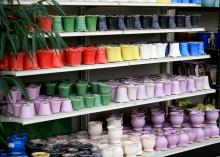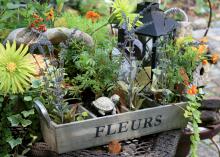Information Possibly Outdated
The information presented on this page was originally released on February 23, 2015. It may not be outdated, but please search our site for more current information. If you plan to quote or reference this information in a publication, please check with the Extension specialist or author before proceeding.
Ease spring fever with combination containers
This past weekend really had me thinking about gardening and landscaping. It was an unseasonal 79 according the thermometer at my house, and I started to putter around the yard, trying to decide what needed to be done to get ready for spring.
Of course, I made a trip to see what plants were on the benches at the local garden center. But by afternoon, I had come to my senses. According to the weather forecasted for this week in much of Mississippi, we haven’t seen the last of winter.
So what’s an eager gardener like me to do? One of my favorite prescriptions for easing a case of spring fever is to put together a combination container.
Putting together beautiful flowers and colorful foliage and enjoying combination containers is a pretty easy process. Just gather some pots and plant them with everything from heirloom vegetables to flowers or any other type of plant you like. It is an uncomplicated way to scratch that gardening itch when gardening in the landscape is not practical.
One convenient aspect of combination containers is that you can easily change out plant materials to match the season.
I believe more thought should be put into the container itself. I have a lot of fun picking out the container for combination planting. You can go old school and use classic terra cotta. There’s also a large selection of glazed ceramics to fit into any design scheme.
These containers can be very heavy and difficult to move. A solution is available in containers made out of foam-like materials that look just like their heavier cousins.
If you’re a fan of home remodeling shows like I am, finding something you can repurpose can be very satisfying. The uniqueness and beauty of these objects can serve as focal points themselves. Old-fashioned potato chip cans or wine crates are useful to the creative container garden designer.
Probably due to my nursery and greenhouse background, I like to grow things in the basic, black plastic pots. While very functional, these black plastic containers are very dull. An easy way to jazz up these basic containers is to paint them. I like to use textured spray paints that result in a stone-like appearance. With this technique, your selection of containers is limitless.
When putting together a combination container, always start with a good-quality, peat-based potting media that drains well. Never use soil, as the drainage will suffer. Commercial bagged potting mixes are engineered for optimum water holding and drainage for growing plants in containers.
Even with the improved container soil mixes, watering is an essential chore for your combination container to be successful. I think the quickest way to tell if the container needs water is to push your index finger into the media. If it feels dry at the first knuckle, go ahead and water. To make watering chores easier, your local home improvement store has all the fittings and supplies needed to set up an inexpensive, timer-controlled irrigation system.
Another benefit of combination containers is that they are mobile. You can move them into the sunlight or out of the sunlight, and into the front yard or out to the backyard. You can even move them out of sight when the plants start going down hill.
Their mobility means you have landscape flexibility, especially when your landscape has a lot of pavement. Container combination plantings allow you to have the joys of gardening even when you don’t have any soil to grow in. Whether your outdoor space is a balcony, porch or very small yard, the perfect container means you’re no longer limited in what you can grow.









